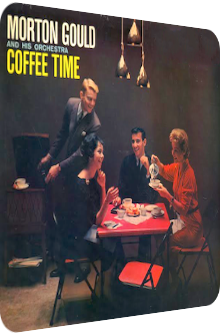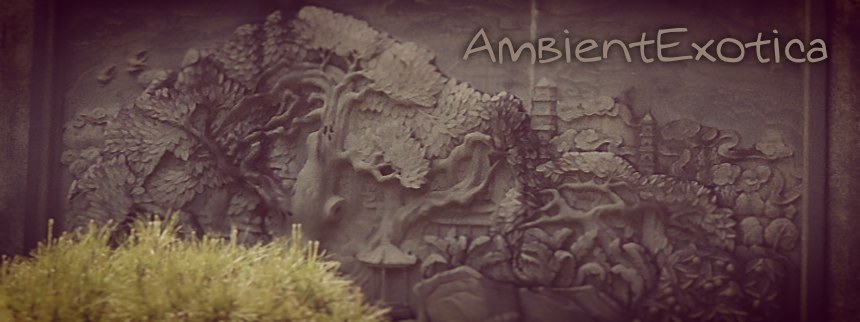
Morton Gould
Coffee Time
1958
Even though Morton Gould (1913–1996) was one of the greatest conductors and arrangers of the United States, I find it funny how he occasionally became a victim of the marketing buffs at record labels trying to come up with an overarching concept that Gould would then fill with the usual 12 selected cuts. The good people at RCA Victor were truly creative and developed the following concept: since Morton Gould is, according to the liner notes, an "experienced connoisseur and brewer of coffee," why not let him provide the fitting aural background for a Sunday afternoon with good friends at the coffee table? I believe that even if Gould did not brew his own coffee, it would have been sufficient enough for the former child prodigy to just know about the existence of this hot beverage in order to be considered for this project. But why the bile?
Coffee Time, released in 1958 on RCA Victor, is actually a profound Space-Age album with a focus on the usual Easy Listening ingredients: lavish strings of all kinds and colors in tandem with mature brass accompaniments. However, you can definitely apply the Exotica label here, if not to the whole work, then at least to side B which not only expands the pool of instruments, but takes a bow before Morton Gould's better known work and predecessor to Coffee Time, the multi-faceted Jungle Drums from 1957 off which Gould takes his own brilliant composition Tropical and arranges it in a different way. So without further ado, whether there is coffee in front of you or not, I am going to check out the twelve interpretations, some of them quite rare or even exotic by Exotica standards.
The album launches with the world-famous Mexican Hat Dance and remains close to the original instrumentation that is christened Jarabe Tapatío. Naturally, the idea of a full orchestra playing this acoustic guitar-targeting ditty is bewildering, but at the same time unique. Well, at least it was comparably exceptional back then in the 50’s. Despite the obvious use of orchestra strings, Gould adds the expected clicking castanets into the mix, but does not shy away from embedding dreamy instruments like the harp and paradisiac flutes into the soundscape. Bassoons and bass flutes are admixed as well, the interplay between quieter and more dynamic patterns is eclectic. Mexico might not be an exotic destination for West Coast Americans, but it definitely was and still is an intriguing destination for Europeans.
The final brass flourish at the end leads to Serenade In The Night by Bruno Cherubini, Cesare Bixio and Jimmy Kennedy, and chances are that one likes the first half of the arrangement much more than the second, for the orchestra instruments keep a low profile, meandering along gently. Even the pizzicato strings are silky, as are the good-natured brass stabs. The second phase, however, succeeds with its lavish strings which are even warped in a style close to Les Baxter. The nocturnal scenery is well-played, and the melodies are complex enough to break the boundaries of the Easy Listening genre, if only very slightly so.
Up next is a take on David Raksin’s and Johnny Mercer’s Laura. The phantasmagoric opening passage, ensuing violin waves and harp cascades are among the best, that is until the lead fiddle is playing shortly after the first minute. It is here where things become a tad too tawdry. But it then mostly vanishes into the distance most of the time, never destroying the mesmeric superstructure. This might well be the best tune of the album, and yes, it depicts the soothing kind of orchestral Exotica, as its lushness evokes blissful beach nights. While Grigoraş Dinicu’s Romanian Hora Staccato of 1906 is a largely unknown artifact in the Lounge worlds and is only remarkable here due to the prominent use of coruscant glockenspiels and the mellow harp strings in an otherwise euphonious but convoluted setup, The Man I Love by brothers George & Ira Gerswhin turns out to be a bit too melodramatic and doleful in the hands of the conductor, but Gould then accomplishes to rev up the dreaminess of the harp even more, as its timbre almost mimics Asian tone sequences; in tandem with the clinging mallet instruments, both groups of instruments take a stand against the bolstering strings.
The final tune of side A is Serenata, but it does not tell in the liner notes which serenata it is, and my knowledge in this regard is only very basic. Rest assured that the fulminant entendre of the staccato horns and frantic strings is lessened in its aggression by the echoey castanets, with the second half of the composition moving into legato climes with an actually quite uplifting and less clichéd melody. The downwards spiraling warbled flutes are a bonus and end side A with a scent of tropical madness.
If you ask yourself at this point if the material of Coffee Time justifies a review, as its connections to the Exotica genre are slim to none up to this point, then rest assured that side B is more compelling, as four potentially tropical pieces made it on there. The symphonic setting naturally remains, but the pool of instruments is expanded and the spirit is more convivial than before. Arthur Benjamin’s 1938 smash hit Jamaican Rumba proves this assertion to the point, and while it has been out of place on Andre Kostelanetz’s Lure Of The Tropics (1954), it is a fitting inclusion on Gould's LP, and equally short, with less than two minutes of a rapid-firing but silky string whirlings, piano chords, xylophone droplets, high-toned clarinets and mellifluous trumpets. The instrumentation is surprisingly less orchestral than expected, maybe due to the variety of instruments and the bubbling setting.
Duke Ellington’s following Jazz standard Solitude is presented here as a wonderfully languorous legato piece with vibraphone scintillae and cozy harp washes. However, some of the lead strings unfortunately play in a questionable way: over the top and too impassioned. But I can cope with this shortcoming, as the waves of strings wash over the listener in an enthralling way. In the end, I even consider it one of the top picks of the album.
A string of three Exotica-related tracks follows, and it is here where true Exotica buffs will be reminded on the predecessor Jungle Drums, both in terms of the style and the featured material. Lady Consuelo Velázquez’s Bésame Mucho is an overly romantic piece, but Morton Gould makes several things terrifically right on this version. I don’t know where to start: the sunset-colored Balearic guitar twangs are awesome, the sizzling maracas – a first on the album – add plasticity to the arrangement, and the luminescence of the iridescent harp licks glows from the background and outshines the remaining instruments in each and every second where the harp occurs. It is by no means my favorite version of Bésame Mucho, as I prefer Michel Magne’s positively crazy take off his 1962 album Tropical Fantasy anytime, but Gould’s try is worth your while in any case. And it so happens that his own Exotica masterpiece, Tropical, follows. Arthur Lyman’s version, included on The Legend Of Pele (1959), outclasses Gould’s poster child, but cannot by the very nature of Lyman’s quartet feature the majestic depth and opulence of Gould’s orchestra.
While Tropical was already featured on Gould's Jungle Drums, the conductor comes up with a new take of this tune on Coffee Time. Clarion horns, refreshingly clicking claves, spiraling harp licks, dulcet flutes and wonderfully euphonious strings altogether make up a highly melodious tune. Best of all is the reduction of pompousness. The strings only rise on one occasion, but after this exhilarative outburst, the setup remains smooth and purposefully under the radar. It is a magnificent tune and Morton Gould’s truly Exotica-related legacy. Orchids In The Moonlight by Gus Kahn, Edward Eliscu and Vincent Youmans can be considered an exotic piece as well, if only for the fact that it was written for the 1933 adventure flick Flying Down To Rio. Gould marries the Tango rhythm and the pizzicato strings with an actual harpsichord, a curious choice as it only boosts the demotic baroque flavor, but a noteworthy Space-Age-related inclusion nonetheless.
The whopping five minutes of the final Manhattan Serenade, originally composed by Louis Alter in 1928, exchange the tropical jungle for a concrete jungle and probably lead into the most aqueous take, with the harps, flutes and glockenspiels being more upfront than before. The same can also be said for the trumpets which provide the energetic counterparts to the depicted mirage. The duration and the many actions and reactions of the instruments make it the most complex offering. And so ends a symphonic Easy Listening album with decidedly noteable Exotica borrowings.
Coffee Time is a good album if one views it through Exotica glasses, as not only the three to four exotic compositions of side B fall into that category, but the particularities of Gould's arrangements in general: there may be no vibraphones or ukuleles on this album, not even a cleverly used bongo-esque drum, but the glitzy glockenspiels and liquid harp drops are good contenders and add gently breezes of the Tropics which are often used in other symphonic depictions as well. I am a huge fan of the harp anyway, so this might be the reason of my fondness of Gould's production-related techniques. Then again, there is no need to poeticize the lack of truly exotic outings, for the concept of the album, the artwork and the horrible liner notes altogether do not support the idea of linking this work to the Exotica canon. However, it is, I believe, close enough, with the interpretations of Laura or Serenade In The Night being tremendously dreamy.
All in all, Coffee Time is no swinging Jazz album anyway, it is meant to be consumed next to a sizzling-hot coffee. Or as Robert A. Simon, the texter of the liner notes, states: "[The orchestra] 'goes with' the music – as the music 'goes with' your coffee." While such irrelevant observations propose a snarky comment or two from your – now not so humble – reviewer, I will leave it at that: Coffee Time is a good Space-Age or Easy Listening album with four Exotica cuts and several related, dreamy elements in all remaining compositions of the symphonic kind. While it is no essential release, it is recommended. It is available on vinyl and in the form of a digital re-issue from 2009 by Hallmark.
Exotica Review 192: Morton Gould – Coffee Time (1958). Originally published on Mar. 16, 2013 at AmbientExotica.com.
